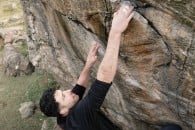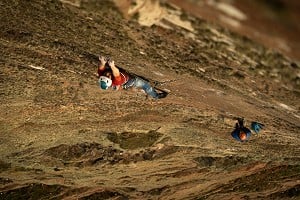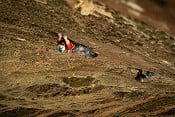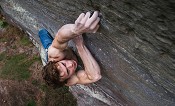
The Groove (E9 7b) has long captured the imagination of Gritstone aficionados.
Described in Rockfax as a route that was 'lusted after for generations', The Groove received its first ascent at the hands of a young James Pearson in 2008. The route has two cruxes, both of which, for Pearson at least, revolved around technical and precise footwork on blank rock.
In November 2008, just nine months after Pearson's ascent, the route received a second partial ascent at hands of visiting American Kevin Jorgeson - or, as UKC reported at the time - 'Kevin Jorgeson has repeated almost all of The Groove'.
Whilst Kevin climbed through the first crux, he then took a different line, finishing via easier climbing and so avoiding the second crux entirely.
Two days ago, more than sixteen years afters James' ascent, the original line received its first repeat at the hands of Alex Moore. UKC spoke to Alex earlier today to find out more:
Congratulations on climbing The Groove! How did it feel?
Thanks! It felt much worse than I had been expecting, I'd had a couple of sessions on top rope and they felt a lot better, but that was in colder weather which makes a huge difference on the route.
The arete actually sits in the sun and on the day we faffed around trying to get it done by the shade of a passing cloud! In the end we climbed a couple of classics and waited for the shade to come around and that tipped the scales, only just, mind, it still felt atrocious on lead.
Generally speaking though, it felt great, the moves are brilliant and the feature is world class. I maintain that the gritstone in that area of the peak is the best there is (in the peak that is, some of the stuff in Yorkshire is truly wonderful). It has a good grain size and consistency which makes all the routes and boulders at Cratcliffe Tor, Rowtor Rocks, Robin Hood's Stride, etc worthwhile.
It's such a mythical route, how long has it been on your radar, and when did you decide it was something you were going to try?
Without sounding too fairy-tale about this, I was given Progression for Christmas the year I started climbing (my mother turned it off because she thought the Americans were ruining Christmas), so I've always been aware of it.
I also think the controversy around its grade and who has or hasn't done it hasn't marred the route as much for me as it seems to have for some people; grade debates bore me more than golf. At the end of the day someone may or may not have been wrong about something, that happens all the time and it's fine. The route is surely the main thing, and this one's excellent.
Am I right in thinking that you followed the same line as James, rather than the one that Kevin Jorgeson took? How do the two lines differ, and how do you think this affects the overall difficulty of the route?
Yes, I followed the same line, but I dyno the final hard moves, whereas James laybacks a crimp.
Essentially, I climb the left-hand side of the arete and James the right-hand. So depending on how much of a purist you are, you might think I've climbed it and you mightn't, but I've definitely done it a lot more than Kev has.
Kev avoided the top crux because it's very height dependent, my dyno is very 'how-high-can-you-jump' dependent, and I have a very good static jump, I can't comment on Kev's.
Talk us through the crux sequences, what is it that makes them so difficult? They look incredibly delicate!
I suppose they're difficult because they almost never happen, the one-handed dyno is almost unique – I can't think of other examples. Thereafter, the crux is very insecure, holding the position is difficult and jumping out of it feels counter intuitive.
How did you go about working the route?
I worked it on my Taz, and - on a serious note - I think I left it at Black Rocks the other day, so if anybody reading this has stumbled upon it, I'd love it back.
I just worked out the beta, roughly what gear I'd need and gave it a go on the first opportunity I had a belayer. Days off, weather, and belayers are a rare trifactor, you have to jump at these opportunities!
How about gear, what did you use, how did it feel, and did it all go in on lead?
I used quite a lot for the crux compared to the other guys because I don't own sliders. I got two no.1 DMM dragon fly's in, one either side of the arete and then three RP's on the right, they were fiddly to place but you can stand on the ledge and use both hands if you're careful. I fell off a couple of times and only one of the RP's came out.
Talk us through the successful attempt, how did it feel on lead?
Awful, I hadn't done it with the ropes before and they were all over my knees. Also whatever solo toprope set up you have, you'll inevitably get some slight support from the rope and even something very slight will affect such delicate moves and make the lead feel a touch more insecure.
Alex recorded the ascent on his tried and tested shoe-cam
Do you have any other projects on the go/lined up?
Yes and no, I have a dodgy knee and some finger injuries, so I have to be careful what I try and should maybe just have a hot bath instead. I'm always keen though, so we'll see what I can squeeze out of the end of the season before summer starts and I cease to function.
























Comments
Congrats to Alex, can't believe it's 16 years since first ascent.
As a punter, here's some thoughts on whether an ascent of the groove is "on line" purely from looking at photos of the rock at Cratcliffe (and having stood underneath 😁)
The lower bit of the groove is fairly straightforward, climbers body is to the right of the groove but the edge is clearly being used for left hand so definitely climbing the groove feature.
The upper bit of the groove curves over to the arete on the left:
If it was climbed similarly to the bottom bit, i.e. climbers body to the right but left hand on the edge then I'd say that was climbing the groove feature. If it was climbed with the climbers body in the groove itself (the bit where the crack fizzles out), then regardless of whether finished above and left hand on arete or pull up/out left and right hand on arete then I'd say that was climbing the groove feature. If it was climbed with body to the left of the arete (from the horizontal break at the top of the twin cracks) with right hand on the arete especially before the groove closes off, then I'd say that was not climbing the groove feature.Note that I've no idea how any of the 3 ascentionists did those moves, or where the route as "defined" by the first ascent exactly goes. It's purely me conjecturing what would be a valid ascent of the totality of the groove rock feature, not whether someone's validly climbed a route or not.
Cratcliffe was my local crag for a long time and I do love the place.. but the Groove (route) just doesn't really seem a great line, and maybe that's because its called the Groove, but the route isn't in the groove, but to the right/on the right edge. It's strange as well that clearly its really hard and yet looks quite safe from the videos (1 hard move with gear, then appear to be at the next bomber gear). It's certainly not as aesthetic as Gaia, Meshuga, Partian Shot, The End of the Affair etc. But kudos to anyone who can climb it!
Edit - looking at pictures again... the groove is an impressive line, but the climb doesn't really climb the actual groove. So I think really it's been poorly named, which confuses things for me! But what do I know !
I think that this dissecting of the style of ascent by climbers at our level is kind of sad. There´s a line and an obvious feature; how you climb it is your own decision, as long as you stay on/in the feature and don´t avoid the difficulties which were the signature of the first ascent (as Jorgeson did, so only two true ascensionists to date, not three).
There are parallels to other major Grit testpieces. To quote Mick Fowler, writing about Profit of Doom (E4 6b) in Extreme Rock: "On the first ascent, John Allen bridged the whole thing, but nowadays you reach for a hidden hold on the left arete". Nobody quibbled about the new beta; the groove had been climbed, so or so, and that was enough.
Same with Parthian Shot (E10 6c); Dunne, Grieve, Bransby and especially Pearson all used different methods, but all these ascents were celebrated.
I honestly don´t think it´s up to us punters to discuss the finer points of ascents at this level. Alex said that he was terrified during his ascent (even though Simonfaraway writes that it looks quite safe); who are we to judge?
If you read my post properly you'd see that I explicitly wasn't dissecting the style of ascent by the climbers who have done all/part of the route.
I was discussing what line would be considered to have climbed the actual groove rock feature.
With regard to Profit, whichever method is used, the climber's body is clearly within the groove. If you're to the left of the arete then you're on The Fall (E6 6b).